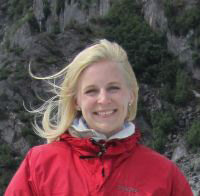Ask NASA Climate | December 8, 2014, 15:49 PST
COP-20: It's all about momentum

One if the two main areas where countries discussed key topics for the day at COP-20 in Lima, Peru.
Michelle Gierach, a JPL oceanographer, answered my Skype call while she was walking with her computer. She leaned over and whispered, “I’m trying to find a quiet place to talk.” Gierach was in Lima, Peru, representing NASA at the United Nations Framework Convention on Climate Change’s 20th Conference of Parties (COP-20), which runs December 1-12.
As she swung her computer around, I could see she was in a massive, white, tent-like structure. There were lots of people, and it was pretty loud. “Where are you?” I asked.

She had come to the U.N. climate conference to speak to international delegates from 195 countries about how climate change affects El Niño. I’d expected her to Skype with me from her hotel room for the interview, but instead, she was at the U.S. Center, which was a sectioned off area inside a massive hangar that held representatives from all the countries. To hide from the noise, she’d ducked behind the NASA hyperwall, a screen of nine linked computer monitors displaying stunning data visualizations.
“That’s hilarious,” I giggled as I asked her to swing her computer around, slowly this time, so I could see what was going on. I called out “Hi from California!” to a group of U.S. delegates, and they waved back at me from Peru.
The point of this year’s U.N. meeting is to draft clear, concise negotiating text to set the stage for next year’s meeting, taking place December 2015 in Paris, where countries are expected to agree on actions to address climate change.
“Just walking around, what I gauge from talking to people in the U.S. Center is excitement that we’re all here," Gierach told me. "But the real excitement will come next year. This is about keeping the momentum going."
All of these people at COP-20 are meeting to make sure everyone is on the same track to reduce greenhouse gas emissions — to keep global warming below 2 degrees Celsius. “But the ocean’s role within these two degrees of warming is key and must to be factored into the equation,” she said. Earth’s oceans have absorbed a lot of heat, and a better understanding of El Niño will improve scientists' ability to forecast complex climate phenomena.
Any of the delegates can watch the science talks on the NASA hyperwall, where Gierach explains how she uses NASA satellite observations to look at how El Niño affects people on local, regional and global scales. She’s in the U.S. Center all day, busting her butt to tell NASA’s story to the climate community. Data animations on the hyperwall, such as a visualization of sea surface temperatures during the giant El Niño of 1997-98 (shown below) provide beautiful eye candy that have helped draw a steady stream of viewers eager to watch and learn.
“I think it’s so cool to be surrounded by people who acknowledge that there is climate change and who actually care. Everybody here sees that there’s a problem and wants to do something about it. It’s so cool to be a part of that,” she said. And then, “Oh, I have to go right now! The next hyperwall talk is about to start!” And then she hung up on me.
“You go gurl,” I thought.
You can watch Gierach's COP-20 presentation here, and you can find more information about the U.N. Framework Convention on Climate Change here.
As always, I look forward to your comments.
Laura
Sea Surface Temperature Anomaly during the the 1997-1998 ENSO event. Credit: NASA
